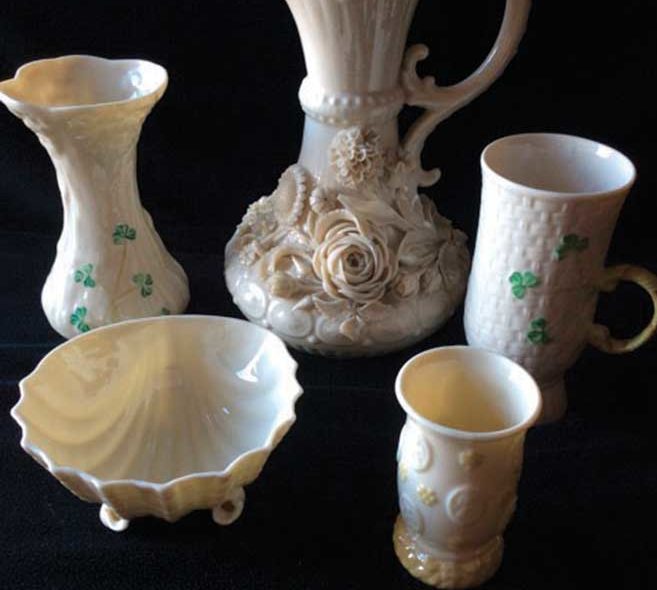timeless
One of the collections started for me many years ago by a friend was Belleek pottery. This creamy, almost translucent, Irish pottery has an impressive history.
The town of Belleek was founded in 1610 and owned by the Caldwell/Bloomfield families. John Caldwell Bloomfield was an amateur mineralogist who inherited the land in 1849 and soon discovered it was rich in feldspar, kaolin and flint. Since a river ran through the property, he had the water power to turn these elements into pottery. Ireland, having gone through a rather tough time with the potato famine, was in need of more industry. Bloomfield had just the business to save his community.
By 1853, Worcester Porcelain Company won highest honors at the Dublin International Exhibition for a dinner service using his clay. He was a success! Queen Victoria and many heads of state have collected and commissioned his unique pieces. In 1882, Bloomfield’s business partner died and his heir wanted nothing to do with the company. When Bloomfield died in 1884, the original Belleek chapter was over. A local group of investors raised the capital to purchase the factory, and they named it Belleek Pottery Works Company Ltd.
Two world wars slowed the production of finer pieces, forcing concentration on basic pottery for consumer use. Things ramped up again after electric kilns replaced coal-fired ones. Today, George G. Moore owns Belleek, and it is part of a conglomorate that also creates Galway Crystal, Aynsley China and Donegal Parian China.
Of course, as with any collectible, age and condition are of paramount importance. In 1926, courts ruled that only the Irish company could use the capital ‘B’ in referencing Belleek; all other manufacturers must use a small ‘b.’
I have been a designer since Moses was a baby, so I have seen it all at least once. I began designing in the 1980s when English, French and Continental furniture were the rage, and English chintz was festooned on windows and upholstery. ‘More is more’ was the mantra. Now ‘less is less’ seems to be the new way, with companies like Crate & Barrel, West Elm, Restoration Hardware and even IKEA attempting to define good design.
I don’t agree with the concept they espouse, but they have all, in one way or another, made attempts to update the classics in a way that can appeal to the younger set—and also to the empty nesters who have lived with the decorative look of the ‘80s and now want a downsized esthetic. Less fun, but I get it.
One great look that has really caught on and I absolutely love is lacquered furniture and mirrors. There is nothing fresher than a lacquered table or mirror. By painting an old Chippendale mirror a bright white, red, green, orange or blue, you can add a pop of color and history to your space. Unless your furniture is museum-quality, don’t be afraid to reinvent it. Your kids won’t want Aunt Matilda’s old brown table anyway. This is an economical way to change your look—remember, paint is our friend.
50 shades of: green
Spring is upon us, so a vast array of greens will soon be surrounding us and making us feel happy that the grays of winter have passed. I love the color and find it goes with almost everything, as if it were disguising itself as a neutral!
The roots of the word from both the Anglo Saxon and Germanic language mean ‘grass’ and ‘grow.’ Minerals, too, offer us an array of inspiring hues, from the stone malachite to verdi, which is created when copper ages. And of course, my personal favorite … emeralds.
Nature, life, health, youth, spring, hopes, and even envy and death are often associated with the color green. In design, green dyes were vastly improved in the 18th and 19th centuries as synthetic pigments and dyes began replacing vegetable and mineral ones.
Of cou
Just as red is used to symbolize royalty or nobility, green represents the rank of merchants, bankers and the gentry and their families. We get a sense of Mona Lisa’s social stature as she wears a green frock.
I leave you with this from the German poet and philosopher Goethe. He opined that green was the most suitable color for decorating bedrooms. How is it that everyone thinks they are a decorator?
